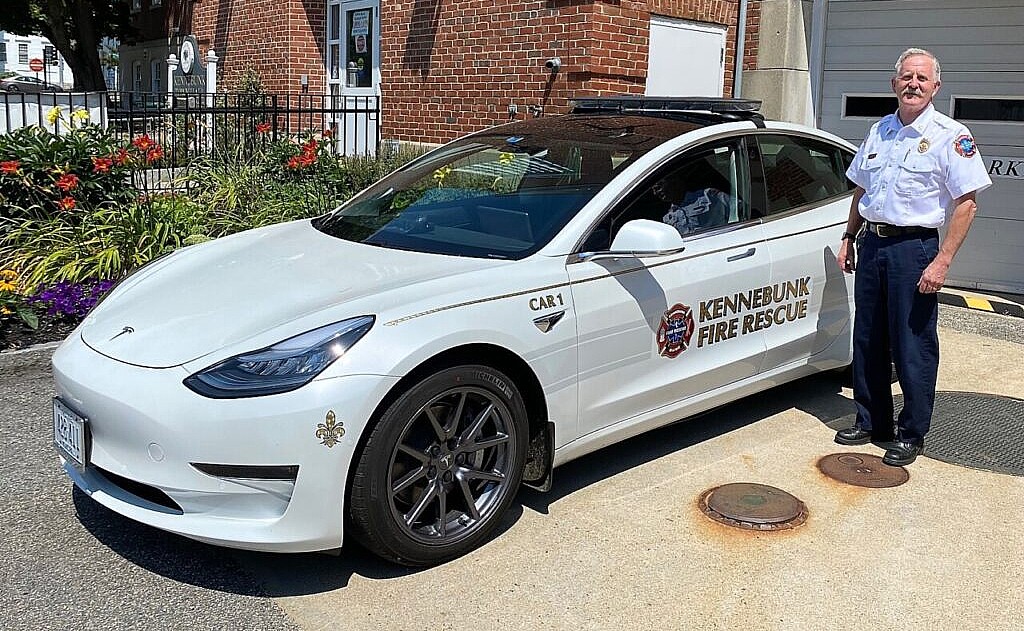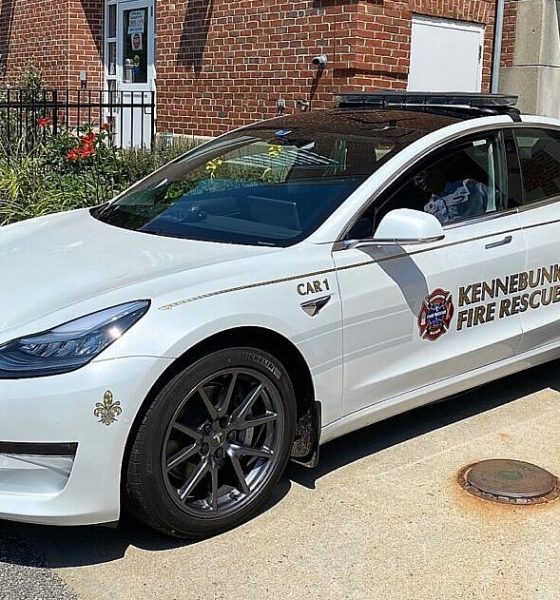

News
Tesla Model 3 selected over Chevy Tahoe as fire chief’s new command vehicle
With the Tesla Model 3 proving itself as a viable alternative to gas-guzzling police vehicles across the globe, it appears that other key organizations such as fire departments are now looking to utilize the all-electric sedan for their operations. Among the most recent places to do this was Kennebunk, Maine, which recently revealed that it has acquired a Model 3 as a command vehicle for the city’s fire chief.
Interestingly enough, Kennebunk Fire Department Chief Jeff Rowe had been looking to acquire a Chevy Tahoe as his next command vehicle when he heard a presentation at the local Rotary Club about the effects of environmental changes. Kennebunk already has committed to energy efficiency, being one of the signatories of the Global Covenant of Mayors for Climate and Energy. Other vehicles were then considered, including the Model 3 itself.
Some say it's mystic….It's electric Boogie woogie, woogie! Way to go Chief Rowe! #marciagriffithsPosted by Kennebunkport Fire Department on Friday, August 7, 2020
However, the Model 3 was more expensive than the Tahoe, and it was above Efficiency Maine’s ceiling, which would have given the vehicle a $7,500 incentive. But it appears that Rowe was really set to drive an electric car, as a Tesla representative later contacted the fire chief about the Model 3’s options. As it turned out, if the fire department ordered a variant with a base white color, the all-electric sedan could meet the threshold for the state’s incentives.
The Kennebunk Fire Department ultimately acquired a Model 3 Dual-Motor AWD variant. The purchase ultimately cost $41,490 including the $7,500 state incentive. This made the Model 3 only $2,000 more than a Chevy Tahoe, and that difference is easily leveled out by the all-electric car’s gas savings. Rowe drives about 9,000 to 10,000 miles annually, after all, which translates to about $1,500 a year on gas. The Model 3, on the other hand, is expected to raise the fire department’s electric bill by $30 per month, which translates to about $360 per year.
For now, the Tesla Model 3 command unit is being used primarily by Rowe, as well as other fire department personnel. It’s used for traveling to inspections, fire calls, related meetings, and out-of-town events. The department is also building a slide-out office at the rear trunk of the Model 3 as a command center of sorts where the chief could keep track of updates at fire scenes. The Model 3’s command center is smaller than those found in SUVs, Rowe noted, though it was quite comparable to the Ford Crown Victorias that were used by the department before.
In a press release, Rowe noted that his transition to the Model 3 actually proved to be quite smooth. There are charging stations in the city, and a Level 2 charger had been installed at the fire department. According to the chief, he typically plugs in the Model 3 when he arrives at work in the morning, and the vehicle is usually fully-charged by noon. He also mentioned that the Model 3 behaves quite nicely on the road, since there’s no wait or hesitation when he presses on the accelerator. There’s just the rush of instant torque propelling the Dual-Motor AWD Model 3 from 0-60 mph in 4.4 seconds.

News
Tesla FSD fleet is nearing 7 billion total miles, including 2.5 billion city miles
As can be seen on Tesla’s official FSD webpage, vehicles equipped with the system have now navigated over 6.99 billion miles.

Tesla’s Full Self-Driving (Supervised) fleet is closing in on almost 7 billion total miles driven, as per data posted by the company on its official FSD webpage.
These figures hint at the massive scale of data fueling Tesla’s rapid FSD improvements, which have been quite notable as of late.
FSD mileage milestones
As can be seen on Tesla’s official FSD webpage, vehicles equipped with the system have now navigated over 6.99 billion miles. Tesla owner and avid FSD tester Whole Mars Catalog also shared a screenshot indicating that from the nearly 7 billion miles traveled by the FSD fleet, more than 2.5 billion miles were driven inside cities.
City miles are particularly valuable for complex urban scenarios like unprotected turns, pedestrian interactions, and traffic lights. This is also the difference-maker for FSD, as only complex solutions, such as Waymo’s self-driving taxis, operate similarly on inner-city streets. And even then, incidents such as the San Francisco blackouts have proven challenging for sensor-rich vehicles like Waymos.
Tesla’s data edge
Tesla has a number of advantages in the autonomous vehicle sector, one of which is the size of its fleet and the number of vehicles training FSD on real-world roads. Tesla’s nearly 7 billion FSD miles then allow the company to roll out updates that make its vehicles behave like they are being driven by experienced drivers, even if they are operating on their own.
So notable are Tesla’s improvements to FSD that NVIDIA Director of Robotics Jim Fan, after experiencing FSD v14, noted that the system is the first AI that passes what he described as a “Physical Turing Test.”
“Despite knowing exactly how robot learning works, I still find it magical watching the steering wheel turn by itself. First it feels surreal, next it becomes routine. Then, like the smartphone, taking it away actively hurts. This is how humanity gets rewired and glued to god-like technologies,” Fan wrote in a post on X.
News
Tesla starts showing how FSD will change lives in Europe
Local officials tested the system on narrow country roads and were impressed by FSD’s smooth, human-like driving, with some calling the service a game-changer for everyday life in areas that are far from urban centers.

Tesla has launched Europe’s first public shuttle service using Full Self-Driving (Supervised) in the rural Eifelkreis Bitburg-Prüm region of Germany, demonstrating how the technology can restore independence and mobility for people who struggle with limited transport options.
Local officials tested the system on narrow country roads and were impressed by FSD’s smooth, human-like driving, with some calling the service a game-changer for everyday life in areas that are far from urban centers.
Officials see real impact on rural residents
Arzfeld Mayor Johannes Kuhl and District Administrator Andreas Kruppert personally tested the Tesla shuttle service. This allowed them to see just how well FSD navigated winding lanes and rural roads confidently. Kruppert said, “Autonomous driving sounds like science fiction to many, but we simply see here that it works totally well in rural regions too.” Kuhl, for his part, also noted that FSD “feels like a very experienced driver.”
The pilot complements the area’s “Citizen Bus” program, which provides on-demand rides for elderly residents who can no longer drive themselves. Tesla Europe shared a video of a demonstration of the service, highlighting how FSD gives people their freedom back, even in places where public transport is not as prevalent.
What the Ministry for Economic Affairs and Transport says
Rhineland-Palatinate’s Minister Daniela Schmitt supported the project, praising the collaboration that made this “first of its kind in Europe” possible. As per the ministry, the rural rollout for the service shows FSD’s potential beyond major cities, and it delivers tangible benefits like grocery runs, doctor visits, and social connections for isolated residents.
“Reliable and flexible mobility is especially vital in rural areas. With the launch of a shuttle service using self-driving vehicles (FSD supervised) by Tesla in the Eifelkreis Bitburg-Prüm, an innovative pilot project is now getting underway that complements local community bus services. It is the first project of its kind in Europe.
“The result is a real gain for rural mobility: greater accessibility, more flexibility and tangible benefits for everyday life. A strong signal for innovation, cooperation and future-oriented mobility beyond urban centers,” the ministry wrote in a LinkedIn post.
News
Tesla China quietly posts Robotaxi-related job listing
Tesla China is currently seeking a Low Voltage Electrical Engineer to work on circuit board design for the company’s autonomous vehicles.

Tesla has posted a new job listing in Shanghai explicitly tied to its Robotaxi program, fueling speculation that the company is preparing to launch its dedicated autonomous ride-hailing service in China.
As noted in the listing, Tesla China is currently seeking a Low Voltage Electrical Engineer to work on circuit board design for the company’s autonomous vehicles.
Robotaxi-specific role
The listing, which was shared on social media platform X by industry watcher @tslaming, suggested that Tesla China is looking to fill the role urgently. The job listing itself specifically mentions that the person hired for the role will be working on the Low Voltage Hardware team, which would design the circuit boards that would serve as the nervous system of the Robotaxi.
Key tasks for the role, as indicated in the job listing, include collaboration with PCB layout, firmware, mechanical, program management, and validation teams, among other responsibilities. The role is based in Shanghai.
China Robotaxi launch
China represents a massive potential market for robotaxis, with its dense urban centers and supportive policies in select cities. Tesla has limited permission to roll out FSD in the country, though despite this, its vehicles have been hailed as among the best in the market when it comes to autonomous features. So far, at least, it appears that China supports Tesla’s FSD and Robotaxi rollout.
This was hinted at in November, when Tesla brought the Cybercab to the 8th China International Import Expo (CIIE) in Shanghai, marking the first time that the autonomous two-seater was brought to the Asia-Pacific region. The vehicle, despite not having a release date in China, received a significant amount of interest among the event’s attendees.








